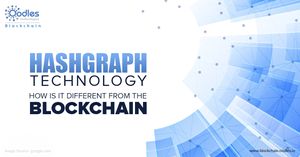-
Below is a comprehensive, in-depth comparison of Hashgraph decentralized ledger technology and traditional blockchain technology. This content is designed to provide clear, well-researched insights backed by technical details and industry best practices. Disclaimer: This article is provided for informational purposes only and does not constitute financial, legal, or investment advice. Always perform your own due diligence and consult with experts like Oodles Blockchanin, a blockchain development company, before making any decisions related to distributed ledger technologies.
Hashgraph Decentralized Ledger vs. Blockchain Technology
Decentralized ledger technologies (DLTs) have revolutionized the way data is recorded, validated, and secured. Among these technologies, blockchain has become synonymous with cryptocurrencies and decentralized applications, while Hashgraph presents itself as an alternative with distinct architectural and performance advantages. In this article, we explore the fundamentals, differences, advantages, and challenges of both systems to help you understand which may be better suited for various applications.
Overview of Distributed Ledger Technologies
Distributed Ledger Technology (DLT) refers to the digital system for recording the transaction of assets in which the transactions and their details are recorded in multiple places at the same time. Unlike traditional databases, DLTs have no central data store or administration functionality.
- Blockchain Technology: Uses a chain of blocks, each containing a list of transactions. These blocks are cryptographically linked and secured, forming a single, linear history.
- Hashgraph Technology: Employs a directed acyclic graph (DAG) and a “gossip-about-gossip” protocol, enabling each node to share information rapidly and efficiently without the need for sequential block confirmation.
What Is Blockchain Technology?
Blockchain is the pioneering technology behind Bitcoin and many other cryptocurrencies. It is characterized by the following features:
- Structure: Transactions are grouped into blocks. Each block is cryptographically linked to the previous one, ensuring data integrity and chronological order.
- Consensus Mechanisms: Blockchain networks employ various consensus protocols, such as Proof-of-Work (PoW) or Proof-of-Stake (PoS), to validate transactions. These mechanisms are designed to be resilient against malicious attacks but can suffer from scalability issues.
- Security and Transparency: The immutability of the blockchain ledger, combined with decentralized consensus, provides strong security assurances and auditability.
- Decentralization: Many blockchain systems (like Bitcoin and Ethereum) are permissionless, meaning anyone can join and participate in the network.
For further insights, refer to the Bitcoin Whitepaper and Ethereum's official documentation.
What Is Hashgraph Technology?
Hashgraph is a distributed ledger technology that diverges from the traditional blockchain approach. Developed by Leemon Baird and implemented by Hedera Hashgraph, it offers several unique features:
- Consensus Algorithm: Hashgraph utilizes a gossip-about-gossip protocol combined with virtual voting, enabling nodes to reach consensus quickly and with a high degree of fairness.
- Performance: The architecture is designed to support high throughput—potentially thousands of transactions per second—while maintaining low latency and low transaction fees.
- Security: Hashgraph claims to achieve asynchronous Byzantine Fault Tolerance (aBFT), which is one of the highest standards for security in distributed systems.
- Governance Model: Platforms such as Hedera Hashgraph use a council-based governance model involving major organizations, which can raise questions about decentralization relative to permissionless blockchains.
For more technical details, visit the Hedera Hashgraph Documentation.
Key Comparison Areas
A. Consensus Mechanisms
- Blockchain:
- Method: Relies on mechanisms like PoW or PoS.
- Pros: Time-tested, highly decentralized (in many cases), and proven secure against certain attack vectors (e.g., 51% attacks are mitigated by high network participation).
- Cons: Can be resource-intensive (especially PoW), slower transaction confirmation times, and potential scalability issues.
- Hashgraph:
- Method: Uses gossip-about-gossip and virtual voting.
- Pros: Faster consensus with high throughput and lower energy consumption; achieves aBFT, ensuring strong security.
- Cons: Governance and decentralization are often more centralized (e.g., via a governing council), which may limit the permissionless nature compared to traditional blockchains.
B. Transaction Speed and Scalability
- Blockchain:
- Transaction Speed: Varies by network; Bitcoin averages 3–7 transactions per second, while Ethereum processes roughly 15–30 TPS (transactions per second) without layer-2 solutions.
- Scalability: Often faces challenges with network congestion and higher fees during peak demand periods.
- Hashgraph:
- Transaction Speed: Designed for high throughput, supporting thousands of TPS with minimal fees.
- Scalability: The gossip protocol scales efficiently with network size, reducing latency and improving overall performance.
C. Security and Data Integrity
- Blockchain:
- Security Model: Based on cryptographic hashing, decentralized validation, and immutability of the ledger.
- Data Integrity: Strong, due to the cumulative proof-of-work or staking mechanisms.
- Hashgraph:
- Security Model: Achieves asynchronous Byzantine Fault Tolerance (aBFT), which is considered highly robust.
- Data Integrity: The virtual voting and gossip protocols ensure all honest nodes eventually agree on transaction order without relying on sequential block production.
D. Decentralization and Governance
- Blockchain:
- Decentralization: Many blockchains are permissionless, with no central authority controlling the network.
- Governance: Often community-driven or based on open-source protocols, though some platforms incorporate off-chain governance mechanisms.
- Hashgraph:
- Decentralization: Generally operates on a permissioned model (as seen with Hedera Hashgraph), where a selected council governs the network.
- Governance: This council model aims to provide stability and regulatory compliance, but it may reduce the level of openness compared to fully decentralized blockchains.
E. Use Cases and Applications
- Blockchain:
- Applications: Cryptocurrencies, smart contracts, decentralized finance (DeFi), supply chain management, voting systems, and more.
- Ecosystem: A vast ecosystem with extensive developer communities, numerous protocols, and widespread adoption.
- Hashgraph:
- Applications: Suitable for high-performance enterprise applications, real-time data processing, micropayments, and use cases where speed and low latency are critical.
- Ecosystem: Growing, with increasing adoption in enterprise contexts and partnerships that emphasize speed and efficiency.
Also, Explore | Ethereum Distributed Validator Technology | DVT for Staking
Advantages and Challenges
Blockchain Advantages
- Maturity and Proven Security: Years of real-world testing and a large body of academic research support blockchain's security model.
- Decentralization: Many blockchain networks operate in a permissionless environment, promoting transparency and resistance to censorship.
- Vibrant Ecosystem: Extensive developer communities and a wide range of decentralized applications.
Blockchain Challenges
- Scalability: Many blockchains face limitations on TPS, leading to higher transaction fees and longer confirmation times.
- Energy Consumption: Particularly for PoW systems, energy use can be significant.
- Latency: Confirmation times may be slower compared to newer technologies like Hashgraph.
Hashgraph Advantages
- Speed and Throughput: Capable of handling thousands of transactions per second with low latency.
- Energy Efficiency: Consensus achieved via gossip protocols and virtual voting requires significantly less computational power.
- Robust Security: aBFT ensures high levels of security and fault tolerance.
Hashgraph Challenges
- Governance and Decentralization: The permissioned nature and governance by a limited council may be seen as less decentralized.
- Adoption and Ecosystem: While promising, Hashgraph's ecosystem is not as extensive as that of established blockchains, potentially limiting interoperability and community support.
Also, Check | Distributed Ledger Technology (DLT) for Business Solutions
Conclusion
Both blockchain and Hashgraph offer robust solutions for building decentralized applications, but they cater to different needs and priorities:
- Blockchain Technology remains a proven and widely adopted framework ideal for applications that benefit from its permissionless nature, robust security, and vast ecosystem. It is well suited for projects where decentralization and community-driven governance are paramount.
- Hashgraph Technology presents an appealing alternative for applications that demand high throughput, low latency, and energy efficiency. Its innovative consensus mechanism provides rapid and secure transactions, making it ideal for enterprise applications and high-frequency use cases.
Ultimately, the choice between Hashgraph and blockchain technology will depend on your specific requirements—whether that's the need for maximum decentralization and a broad ecosystem, or a focus on performance and scalability.
For further reading and in-depth technical resources, consider these links:
By understanding the strengths and limitations of each technology, developers and decision-makers can better align their projects with the most appropriate distributed ledger solution.
As technology and regulations evolve, we recommend staying informed through ongoing research and consulting with industry blockchain developers and experts like at Oodles.

Our Offices
INDIA
Emaar Digital Greens, Sector 61,
Gurugram, Haryana
122011.
Welldone Tech Park,
Sector 48, Sohna road,
Gurugram, Haryana
122018.














